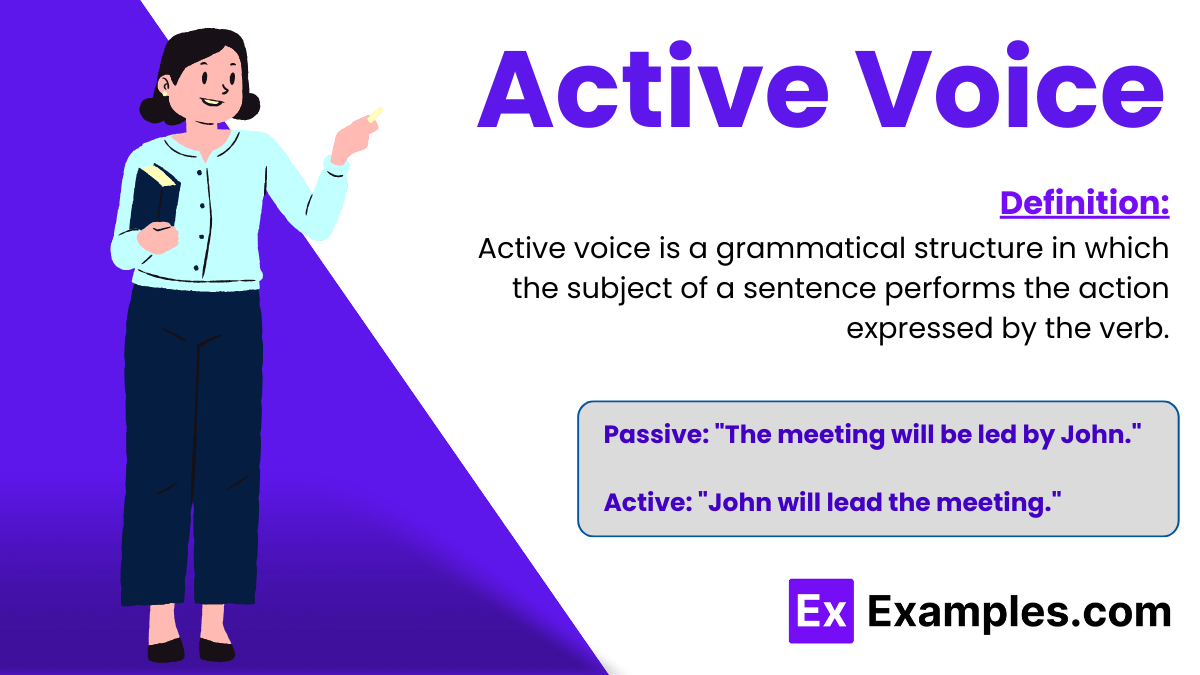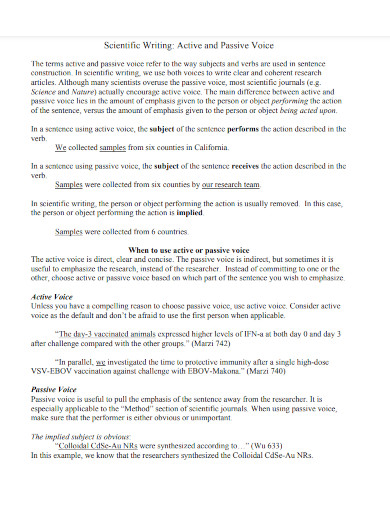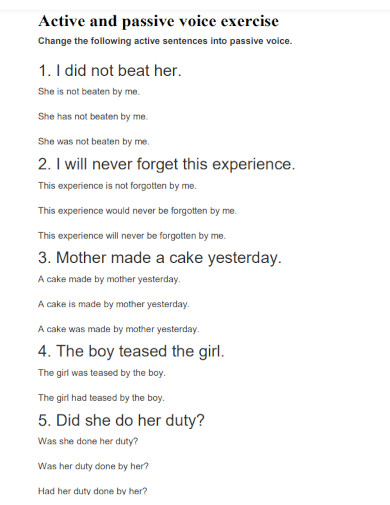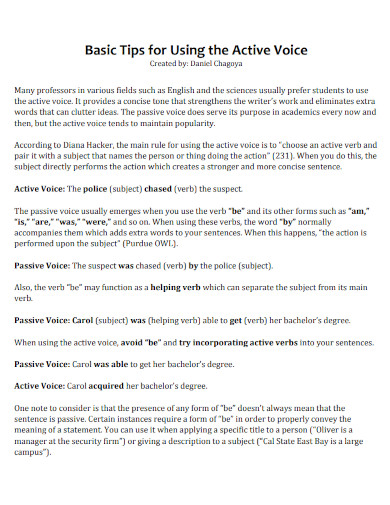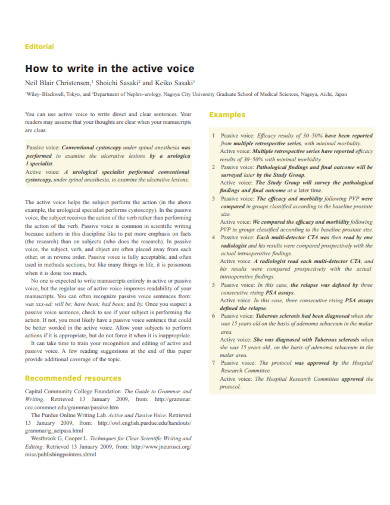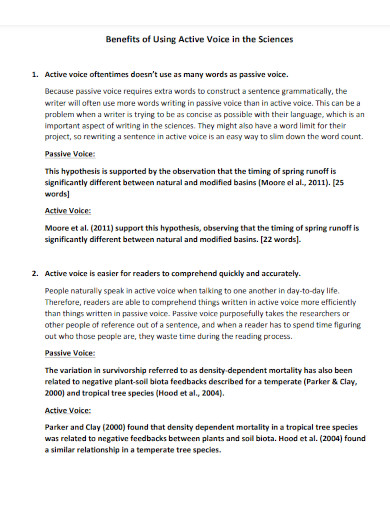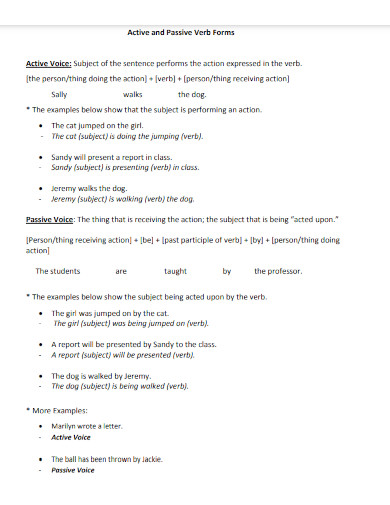70+ Active Voice Examples
Active voice is a grammatical construction where the subject performs the action stated by the verbs, directly affecting the object. This voice emphasizes the doer of the action, making simple sentence clear, dynamic, and straightforward. It is often preferred in writing for its directness and energy.
What is Active Voice?
Active voice is a grammatical structure in which the subject of a sentence performs the action expressed by the verb. This means that the subject is active and directly involved in the action.
Structure of Active voice
The structure of a sentence in active voice typically follows this pattern:
Subject + Verb + Object
- Subject: The subject is the person, animal, or thing that performs the action of the verb.
- Verb: The verb represents the action that the subject is taking.
- Object: The object is the recipient of the action. It is what or whom the action is being done to.
Here are some examples to illustrate this structure:
- “The chef (subject) cooked (verb) the meal (object).”
- “She (subject) writes (verb) a letter (object).”
- “Birds (subject) chirp (verb).” (Note: Not all active voice sentences must have an object, especially if the verb is intransitive, meaning it does not require an object.)
How to Write in Active Voice
- Identify the Subject and Verb: Start by identifying the subject (who or what is performing the action) and the verb (the action itself) in your sentence. The subject should be doing the action.
- Place the Subject Before the Verb: In an active voice sentence, the subject comes before the verb. This order makes it clear who is performing the action. For example, “The manager approved the project” instead of “The project was approved by the manager.”
- Use Direct Language: Choose verbs that are direct and vivid. Avoid forms of the verb “to be” when possible, as they can lead to passive constructions.
- Check for the Object: If there’s an object (the recipient of the action), it usually comes after the verb. For example, “The teacher teaches the students.” Here, “the teacher” is the subject, “teaches” is the verb, and “the students” is the object.
- Minimize Use of “By” Phrases: Passive voice often includes phrases that start with “by.” Reducing the use of “by” can help you shift to active voice. For example, change “The cake was eaten by the children” to “The children ate the cake.”
- Revise Sentences Where Necessary: If you find passive constructions in your writing, rework them into active voice. Ask yourself, “Who is doing this action?” Then rewrite the sentence to put that person or thing at the beginning.
- Practice with Examples: Convert sentences from passive to active voice as practice. For instance:
- Passive: “The ball was thrown by John.”
- Active: “John threw the ball.”
- Be Consistent: Try to maintain a consistent voice throughout your piece. Mixing active and passive voice can sometimes confuse readers, so aim for consistency to improve clarity.
Active Voice vs. Passive Voice
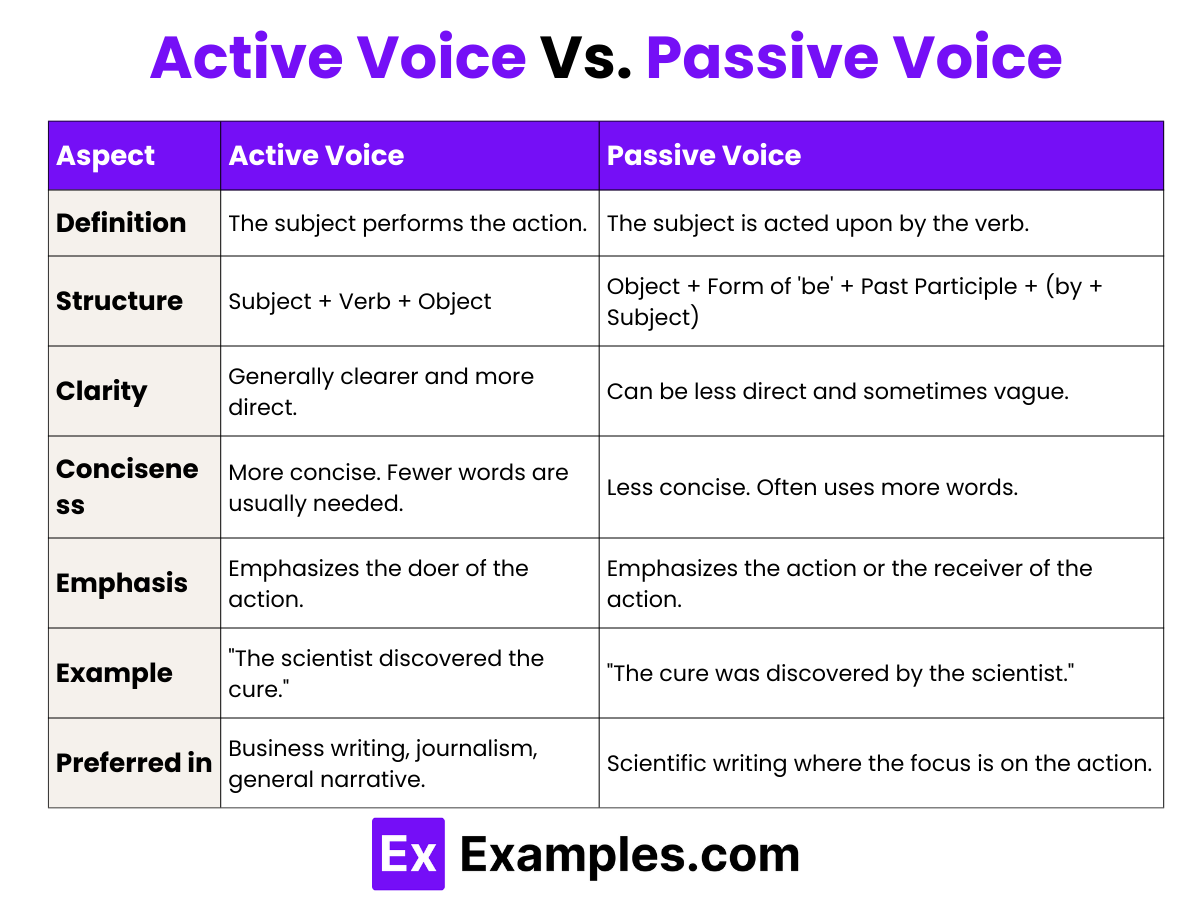
Tips for Converting from Passive to Active Voice
- Identify the Verb and its Form: Look for a form of “be” (am, is, are, was, were) followed by a past participle (usually a verb ending in -ed, -d, -t, -en, or -n). This is a common indicator of passive voice.
- Find the Doer of the Action: In a passive sentence, the doer of the action is often either missing or included in a prepositional phrase starting with “by.” For example, in “The book was written by the author,” “the author” is the doer.
- Make the Doer the Subject: Once you’ve identified the doer, rewrite the sentence so that this doer becomes the subject of the sentence.
- Rearrange the Sentence: Move the new subject to the front of the sentence, followed by the verb, making sure to adjust the verb so it agrees with the new subject and is in the correct tense.
- Eliminate Unnecessary Words: Passive constructions often include auxiliary verb or other unnecessary words. Remove these to streamline the sentence.
- Adjust the Verb: Change the verb form to suit the active voice. If the passive sentence was “The song was sung by the artist,” the active version would be “The artist sang the song.”
- Omit the Agent in Irrelevant Cases: If the original passive sentence omits the doer because it’s obvious, irrelevant, or unknown, you can leave it out in the active version as well. For instance, if the passive sentence is “Mistakes were made,” the active might simply be “They made mistakes” if the “they” is understood from context.
Active Voice Examples in Sentences
- The cat chased the mouse.
- She baked a delicious cake.
- He fixed the broken bike.
- They played soccer in the park.
- The teacher explained the lesson.
- She painted a beautiful picture.
- He wrote a heartfelt letter.
- The dog barked at the stranger.
- The chef cooked a gourmet meal.
- She cleaned the messy room.
- The students solved the math problems.
- He sang his favorite song.
- She watered the plants daily.
- The children built a sandcastle.
- He drove the car to work.
- She read an interesting book.
- The company launched a new product.
- He designed a stunning website.
- She organized the charity event.
- The team won the championship game.
Active Voice Examples in Writing
Using active voice makes your writing clearer and more direct. Here are examples of active voice sentences in different contexts:
Academic Writing
- The researcher conducted the experiment.
- Students completed the assignments on time.
- The professor explained the complex theories.
- The study revealed significant findings.
- The author analyzed the data thoroughly.
Business Writing
- The manager approved the budget proposal.
- The team developed a new strategy.
- She presented the quarterly report.
- The company launched a marketing campaign.
- They signed the contract yesterday.
Creative Writing
- The hero saved the village from the dragon.
- She discovered a hidden treasure in the forest.
- He painted a masterpiece that captivated everyone.
- The storm ravaged the coastal town.
- The detective solved the mystery quickly.
Technical Writing
- The engineer designed the new bridge.
- They installed the software update.
- The technician repaired the faulty equipment.
- The team tested the new product.
- She drafted the user manual.
Everyday Writing
- I cleaned the house yesterday.
- He cooked dinner for the family.
- She watered the garden every morning.
- They played chess in the evening.
- We watched a movie together.
Active Voice Examples in Simple Present Tense
Here are examples of active voice sentences in the simple present tense across different contexts:
Everyday Activities
- She walks to school every day.
- He drinks coffee every morning.
- They play soccer on weekends.
- The dog barks at strangers.
- I read books in my free time.
Academic Context
- The teacher explains the lesson clearly.
- Students participate in class discussions.
- She writes essays for her English class.
- He studies for exams regularly.
- The professor conducts research in biology.
Business Environment
- The manager reviews the reports every Monday.
- She handles customer inquiries efficiently.
- They prepare presentations for meetings.
- He manages the team projects.
- The company invests in new technologies.
Technical Context
- The engineer designs innovative solutions.
- She tests the software for bugs.
- He maintains the network systems.
- They update the database regularly.
- The technician repairs the equipment.
Creative Writing
- The artist paints beautiful landscapes.
- She writes captivating stories.
- He plays the piano wonderfully.
- The actor performs on stage.
- The poet composes meaningful poems.
Active Voice Examples in Present Continuous Tense
Here are examples of active voice sentences in the present continuous tense across different contexts:
Everyday Activities
- She is cooking dinner right now.
- He is jogging in the park.
- They are watching a movie together.
- The baby is sleeping in the crib.
- I am cleaning my room.
Academic Context
- The students are taking a test.
- She is presenting her project to the class.
- He is reading a textbook in the library.
- They are discussing the assignment.
- The teacher is grading papers.
Business Environment
- The team is working on a new project.
- She is negotiating a contract with the client.
- He is writing an email to a colleague.
- They are attending a conference.
- The manager is holding a meeting.
Technical Context
- The developer is debugging the code.
- She is installing new software.
- He is configuring the server.
- They are testing the new application.
- The engineer is calibrating the equipment.
Creative Writing
- The musician is composing a new song.
- She is sketching a portrait.
- He is filming a documentary.
- They are rehearsing for the play.
- The writer is drafting a new chapter.
30+ Active and Passive voice Examples
Active: The cat chased the mouse.
- Passive: The mouse was chased by the cat.
2. Active: Mary paints a beautiful picture.
- Passive: A beautiful picture is painted by Mary.
3. Active: The chef cooked the meal.
- Passive: The meal was cooked by the chef.
4. Active: The teacher explained the lesson.
- Passive: The lesson was explained by the teacher.
5. Active: The gardener is planting new flowers.
- Passive: New flowers are being planted by the gardener.
6. Active: The student answered the question.
- Passive: The question was answered by the student.
7. Active: The manager will approve the request.
- Passive: The request will be approved by the manager.
8. Active: The team won the championship.
- Passive: The championship was won by the team.
9. Active: She writes an email every day.
- Passive: An email is written by her every day.
10. Active: The author wrote a new book.
- Passive: A new book was written by the author.
11. Active: The dog fetched the stick.
- Passive: The stick was fetched by the dog.
12. Active: The photographer took a fantastic photo.
- Passive: A fantastic photo was taken by the photographer.
13. Active: The kids are playing a game.
- Passive: A game is being played by the kids.
14. Active: The judge issued a ruling.
- Passive: A ruling was issued by the judge.
15. Active: The company is launching a new product.
- Passive: A new product is being launched by the company.
1. Active and Passive Voice Scientific Writing
2. Tips Active vs Passive Voice
3. Active and Passive Voice Exercise
4. Converting Passive Voice to Active Voice
5. Basic Tips for Using Active Voice
6. Writing the Active Voice
7. Benefits of Using Active Voice in the Sciences
8. Active and Passive Verb Forms Active Voice
When to Use Active Voice
- Clarity and Simplicity: Active voice is straightforward and easier to understand, making it ideal for explaining complex ideas or instructions. It places the subject at the beginning of the sentence, immediately clarifying who is doing what.
- Conciseness: Active voice often requires fewer words than passive voice, making sentences more concise. This is particularly useful in business writing, journalism, and any context where space and reader attention are limited.
- Engagement and Dynamism: Active voice makes your writing more lively and engaging. This is crucial in storytelling, advertising, and persuasive writing, where keeping the reader’s interest is essential.
- Authority and Responsibility: In business and professional writing, active voice helps to assign clear responsibility for actions or decisions. It’s assertive and shows confidence, which can enhance the credibility of your message.
- Instruction and Direction: When giving instructions or directions, active voice helps to ensure that the steps are clear and direct. For example, manuals and recipes benefit from active voice because it tells the reader exactly who should do what, reducing confusion.
- Emphasis on the Doer: When it’s important to highlight who is performing the action, active voice is the best choice. This can be important in journalistic writing or legal contexts, where the subject of the action is significant.
Benefits of Using Active Voice
- Clarity and Directness: Active voice makes sentences clearer by directly stating who is doing what. This straightforward approach reduces ambiguity and confusion, making it easier for readers to understand the message.
- Conciseness: Active voice often results in shorter, more to-the-point sentences. Without the extra words typically required in passive constructions, active voice allows for more concise communication, which is especially valuable in professional and business settings.
- Engagement: Sentences written in active voice tend to be more dynamic and engaging. This style can capture and hold the reader’s attention better than the often more stilted and formal passive voice.
- Authority and Responsibility: Active voice can convey a stronger sense of authority and accountability. By clearly stating who is responsible for an action, it can make statements and directives more compelling and authoritative.
- Improved Flow and Readability: Active voice contributes to a smoother and more natural flow of language, which can enhance the readability of a text. This makes it easier and more enjoyable for the reader to follow along.
- Emphasis on the Subject: Active voice emphasizes the subject performing the action, which can be particularly important in narrative and journalistic writing where highlighting the actions of individuals is crucial.
- Efficiency in Communication: In many forms of writing, especially in journalism, marketing, and everyday business communication, getting to the point quickly is valued. Active voice helps achieve this efficiency, allowing writers to convey their messages in fewer words.
- Positive Tone: Active voice can help create a positive tone by focusing on the action and its doer, which is often lost in the passive voice’s focus on the action’s recipient. This can make the writing feel more lively and proactive.
When should you avoid active voice?
- When the Doer is Unknown or Irrelevant: If the actor in a situation is unknown or irrelevant to the context, passive voice can be more effective. For example, “The store was robbed last night.” In this case, the identity of the robber might not be known or necessary for the statement.
- When the Focus is on the Action or the Recipient: If the focus should be on the action itself or the recipient of the action rather than the doer, passive voice can shift that focus appropriately. For example, in a scientific context, “The experiment was conducted using controlled variables” emphasizes the procedure rather than the researcher.
- To Avoid Blaming: Passive voice can be used to avoid directly blaming someone, which can be diplomatic in sensitive situations. For example, saying “Mistakes were made” is less accusatory than “You made mistakes.”
- To Sound More Formal or Impersonal: In some academic or legal writing, passive voice can create a formal tone or an impersonal narrative style that is often preferred. For instance, “It was observed that…” can sound more formal than “We observed that…”
- When the Doer is Less Important Than the Action: Sometimes, the interest of the sentence is more about what happened rather than who caused it. For example, “Over 100 paintings were stolen from the museum” focuses on the event rather than the thieves.
- In Descriptive and Analytical Writing: In descriptive or analytical contexts, such as formal reports or scholarly papers, using passive voice can help present information in an unbiased and objective manner.
- To Vary Sentence Structure: Using a mix of active and passive constructions can help vary sentence structure, making long passages of text more readable and stylistically diverse.
- To Highlight the Subject at the End: Occasionally, placing the subject at the end of the sentence can emphasize it more effectively, as in “The new vaccine was developed by a small team of researchers,” where the emphasis is on the “small team of researchers.”
How to fix passive voice
1. Identify the Passive Voice
Look for sentences that have a form of the verb “to be” (am, is, are, was, were, be, being, been) followed by a past participle (usually a verb ending in -ed, -d, -t, -en, or -n). These are typically indicators of passive voice.
2. Find the Actor
Determine who or what is performing the action. This might be explicitly stated after a “by” phrase, or you might need to infer it based on the context.
3. Make the Actor the Subject
Once you’ve identified the actor, rephrase the sentence to make this actor the subject of the sentence.
4. Adjust the Verb
Change the verb to make it active. This often means eliminating the form of “to be” and changing the past participle to a simple past or present form, depending on the tense needed.
5. Reorder the Sentence
Place the new subject at the beginning of the sentence, followed by the verb, and then the target of the action (if applicable).
6. Remove Unnecessary Words
Passive voice constructions often include additional words that can be omitted when switching to active voice.
Examples of Converting from Passive to Active Voice:
- Passive: “The ball was thrown by John.”
- Active: “John threw the ball.”
- Passive: “The book was read by the students.”
- Active: “The students read the book.”
- Passive: “A new store will be opened by the company next year.”
- Active: “The company will open a new store next year.”
How to Write in Active Voice
Most readable texts are written in the active voice structure, this is because this type of writing helps improve the flow and readability of the writing. If you want to have a template or tips in writing on the active voice then you may read any of the links above.
Step 1: Familiarize Yourself with The Active Voice Structure
Begin by familiarizing yourself with the structure and format of the active voice type of writing. This will allow you to innately write in the active voice without making it too purposeful.
Step 2: Practice Active Voice Worksheets
One of the best ways to improve your writing is to practice active voice worksheets and instructionals. Since writing is a hard skill, there are many techniques that one can integrate into their writing. The best way to master techniques in hard skills is to put them into practice.
Step 3: Regularly Fix or Convert Sentences Written in Passive Voice into Active Voice
We all make mistakes when we try to create something or have an output. One of the best ways to write in active voice is to fix any instances of passive voice one will have and convert them into active voice. This will help one learn from their mistakes and prevent them from cropping up in the future.
Step 4: Use Writing Software
Sometimes it is very hard to figure out and identify passive voices in our writing. If you want to precisely avoid using passive voices in your writing, then you will need to use writing software to help you catch these mistakes.
FAQs
What is the Rule for Active and Passive Voice?
Active voice follows the structure: Subject + Verb + Object. Passive voice rearranges this to: Object + Form of ‘be’ + Past Participle + (by + Subject, if known).
How Do You Identify Active Voice?
Active voice is identified by the subject performing the action before the verb, and directly affecting the object, if present, making sentences direct and concise.
What Passive Voice Means?
Passive voice focuses on the action or the object affected by it, often omitting or de-emphasizing the doer. It uses a form of ‘be’ followed by the past participle.
What Makes an Active Voice?
An active voice clearly indicates who is performing the action, placing the subject at the start, followed by the verb and then the object. It results in straightforward, engaging sentences.
What is the Rule for Active and Passive Voice?
The rule involves the subject actively performing the action in active voice (Subject + Verb + Object), whereas in passive voice, the focus is on the action or the recipient (Object + Form of ‘be’ + Past Participle).
What is the Active Voice in a Short Answer?
Active voice in a sentence means the subject is directly performing the action described by the verb, usually followed by the object, creating clear and direct statements
Why is it important to write in an active voice?
The majority of non-scientific writing uses active voice. Making the bulk of your sentences active helps readers understand what you’re saying while preventing too long or complex phrases. Even in scientific writing, using the passive voice excessively might make your sentences difficult to understand. This means that an active voice allows the reader to easily read the flow of the text, which improves the reading experience of the written object. Therefore, it is very important to write in an active voice.
How do you identify an active voice?
Active voice refers to the state wherein the doer of the verb in the sentence is stated before the action. To identify whether or not the statement or sentence is in active voice, one must determine the doer of the action and check whether the location of the doer is before or after the verb. For example in the sentence “Brian is heading to the vet to help out his sister.”, Brian (Doer) is the subject doing the verb “ is heading” (Action). The location of the noun “Brian” is before the action of the heading, which makes this sentence an active voice.
How do you rewrite a sentence from passive to active voice?
To rewrite a sentence in the passive voice, you must first identify the doer of the action and its associated action. After you have identified the doer and the action the person or thing has done then you will rewrite the sentence to that of an active voice. For example in the sample sentence or statement “The ice cream bar had been eaten by Allison during the state fair.”, we can easily identify the doer of the action as Allison, and the object receiving the action as the ice cream bar. Afterward, we will then rewrite the sentence ensuring that Allison will come before the ice cream bar. When rewritten in active voice the example sentence will be, “Allison had eaten the ice cream bar during the state fair.”
Active voice is a tone in writing where the doer of the action is stated before the object, person, or thing receiving the action is stated. This type of writing is very important as it will directly show who is doing the action as a way to prevent any misreads or obscurification in one’s text. Not only that but most books, articles, and research papers use active voice as it will not confuse the readers, and will immediately get to the point.



